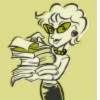 Janisch, Heinz. Lisbeth Zwerger (Ill.) 1997. NOAH’S ARK. New York: North-South Books, Inc. ISBN 0-329-23633-4
Janisch, Heinz. Lisbeth Zwerger (Ill.) 1997. NOAH’S ARK. New York: North-South Books, Inc. ISBN 0-329-23633-4Translated from the original Swiss, author Heinz Janisch’s adaptation of this classic biblical story combines an age-old text with modern illustrations. This juxtaposition facilitates the sharing of NOAH’S ARK in a secular setting. While the biblical phraseology is evident in “he was righteous” and “God had commanded” and “washed the earth clean,” the text is no less accessible to a variety readers. However, this juxtaposition also takes away from the story’s meaning. As someone who is familiar with the story, my focus was drawn to Zwerger’s illustrations. The detailed and realistic illustrations of paired animals are presented in the form of Tables and Figures, much like one would see in an academic diagram. However, the people in the pictures are less accurately represented. The 1960s-clad Noah and his family have disproportionate bodies. In addition, each looks more Swiss in appearance than Turkish—which is historically the more likely culture of Noah’s family. Though this projection of one’s own culture onto biblical characters is common, it is ethnocentrism just the same. These cultural and historical inaccuracies may prove confusing for younger audiences.
If you are in the market for a 'Noah story' that will Wow! you, this probably won’t fit the bill. The illustrations make the target audience a bit older than may be expected for a picture book. Recommended for one-on-one or independent reading for children ages 9-12 years.

No comments:
Post a Comment